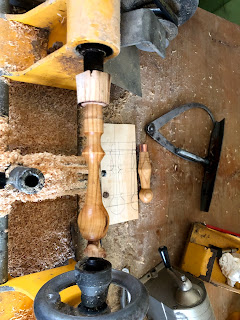Last year, Lost Art Press published measured drawings for the other Roubo book stand scaled to hold their Deluxe edition of "Roubo on Furniture". I grabbed a pdf of the measured drawings and set to make a test build in soft wood before milling some hard wood for the real build.
I quickly ripped some fir to verify that the book stand would accommodate the 1977 edition. So far, so good.
I hadn't cut bridal joints in ages, so they are far from perfect.
Chopping mortises in fir can be fun as the wood is way too soft and crushes easily
Test fit of the book on the assembled top part
Making the support, in pine I believe
The top part is now complete
Making the bottom part is where it gets fun, as it needs a way to hold the top support in position
Chopping the recesses that will hold the toggle in position
All the recesses are chiseled. Here's what I did wrong... I started chopping them from the top but I should have started by the bottom one and made my way up. Chopping was unnecessary in this soft wood... paring down diagonally gave better results and the pared down recesses ended up being the exact dimensions from the drawing.
What I got wrong, part deux, I somehow made the part too long, so I had to shorten it from the bottom.
Fitting the hinges between the top and bottom. The Stanley 271 is so useful for those small mortises.
Finally, adding the two shelves that will support the bottom of the book... I decided to stick a molding on those.
The test build is finished and holds the limited edition without any problem!
The bridal joints at the end of the build were of a better quality than those at the start!





















































